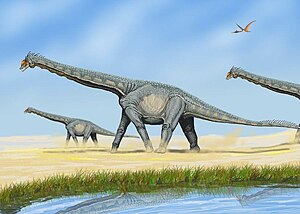Lithostrotia
| Lithostrotia | ||||||||||||
|---|---|---|---|---|---|---|---|---|---|---|---|---|

Live reconstruction of Alamosaurus , a North American lithostrotia |
||||||||||||
| Temporal occurrence | ||||||||||||
| Lower Cretaceous to Upper Cretaceous ( Aptian to Maastrichtian ) | ||||||||||||
| 126.3 to 66 million years | ||||||||||||
| Locations | ||||||||||||
|
||||||||||||
| Systematics | ||||||||||||
|
||||||||||||
| Scientific name | ||||||||||||
| Lithostrotia | ||||||||||||
| Upchurch , Paul M. Barrett & Peter Dodson , 2004 |
The Lithostrotia are a group of sauropod dinosaurs within the Titanosauria . It includes all representatives of the Titanosauria with the exception of some near-original forms such as Phuwiangosaurus or Andesaurus . The Lithostrotia differ from other sauropods mainly in their caudal vertebrae, which were strongly concave (procoel) on the front. The oldest known representative of this group is Malawisaurus from the Lower Cretaceous ( Aptium ) of Malawi . As the last group of sauropods, the Lithostrotia did not become extinct until the Cretaceous-Tertiary boundary 66 million years ago together with all other non-avian dinosaurs.
The taxon Lithostrotia was first established in 2004 by researchers around Paul Upchurch . The name is derived from the Greek lithostrotos (λιθόστρωτος "covered with stones") and refers to the skin bone plates (osteoderms), which are found in different genera.
This article deals with the taxon Lithostrotia from a cladistic point of view - for characteristics and biology of these animals see main article: Titanosauria .
Research history
As early as 1895 Richard Lydekker set up the Titanosauridae family to group sauropods with procoelen (concave on the front) caudal vertebrae. The name Titanosauridae found wide use since then and was (2003) by Salgado and colleagues (1997), Gonzalaz-Riga (2003) and Salgado as a node-based taxon defined ( node-based definition ). According to a suggestion by Wilson and Upchurch (2003), the majority of researchers today refrain from using this name: Wilson and Upchurch published a revision of the genus Titanosaurus and declare the type species Titanosaurus indicus as invalid because it is based only on two caudal vertebrae, the show no diagnostically usable characteristics. These authors consistently consider rank-based taxa based on Titanosaurus as a nominotypical taxon - the Titanosauridae, the Titanosaurinae and the Titanosauroidea - also as invalid. In 2004, Upchurch and colleagues created the new group Lithostrotia to describe the same group previously known as the Titanosauridae - but this time with an unrestricted taxon. The name Lithostrotia is not currently recognized by all researchers.
Systematics
The systematics within the Titanosauria is highly controversial, there is no consensus on the naming of groups. However, many researchers accept the Saltasauridae family as a subgroup of the Lithostrotia, which includes highly derived titanosaurs such as Saltasaurus and Opisthocoelicaudia . The Saltasauridae is often divided into two subfamilies, the Saltasaurinae and the Opisthocoelicaudiinae.
Definition and synapomorphies
Upchurch and colleagues (2004) define the Lithostrotia as a knot-based taxon that includes the last common ancestor of Malawisaurus and Saltasaurus as well as all descendants of this ancestor. According to this definition, the Lithostrotia includes all forms that are more modern (more derived) than Malawisaurus .
In addition to defining the group, Upchurch and colleagues give two jointly derived characteristics ( synapomorphies ) that serve to differentiate the group from other groups. The presence or absence of such features determines whether a genus is classified within the Lithostrotia or not. All but the rearmost (most distal) vertebral bodies of the tail vertebrae were clearly concave (procoel) on the front. In addition, the anterior (proximal) caudal vertebrae were particularly pronounced.
The eponymous osteoderms , on the other hand, do not represent a synapomorphism. In fact, the evolutionary history of osteoderms within the Titanosauria is unknown - this feature may have developed several times independently of each other within the Titanosauria and the Lithostrotia.
Individual evidence
- ^ Gregory S. Paul : The Princeton Field Guide To Dinosaurs. Princeton University Press, Princeton NJ et al. 2010, ISBN 978-0-691-13720-9 , pp. 206-213, online .
- ^ Paul Sereno : Lithostrotia. (No longer available online.) In: Taxon Search. Archived from the original on March 5, 2016 ; accessed on August 28, 2014 . Info: The archive link was inserted automatically and has not yet been checked. Please check the original and archive link according to the instructions and then remove this notice.
- ^ A b c Paul Upchurch , Paul M. Barrett , Peter Dodson : Sauropoda. In: David B. Weishampel , Peter Dodson, Halszka Osmólska (eds.): The Dinosauria . 2nd edition. University of California Press, Berkeley CA et al. 2004, ISBN 0-520-24209-2 , pp. 259-324.
- ↑ Paul Sereno: Titanosauridae. (No longer available online.) In: Taxon Search. Archived from the original on September 3, 2014 ; accessed on August 28, 2014 . Info: The archive link was inserted automatically and has not yet been checked. Please check the original and archive link according to the instructions and then remove this notice.
- ↑ Jeffrey A. Wilson, Paul Upchurch: A Revision of Titanosaurus Lydekker (Dinosauria - Sauropoda), the first dinosaur genus with a 'gondwanan' distribution. In: Journal of Systematic Palaeontology. Vol. 1, No. 3, 2003, ISSN 1477-2019 , pp. 125-160, doi : 10.1017 / S1477201903001044 .
- ↑ Jeffrey A. Wilson: An Overview of Titanosaur Evolution and Phylogeny. In: Fidel Torcida Fernández-Baldor, Pedro Huerta Hurtado (eds.): Actas de las III Jornadas Internacionales sobre Paleontología de Dinosaurios y Su Entorno. = Proceedings of the 3rd International Symposium about Paleontology of Dinosaurs and their Environment Paleontología de dinosaurios y su entorno. Salas de los Infantes (Burgos, España), 16 al 18 de septiembre de 2004. Colectivo arqueológico-paleontológico de Salas, Salas de los Infantes (Burgos, España) 2006, ISBN 84-8181-227-7 , pp. 169-190 .
- ↑ Michael D. D'Emic, Jeffrey A. Wilson, Sankar Chatterjee : The titanosaur (Dinosauria: Sauropoda) osteoderm record: review and first definitive specimen from India. In: Journal of Vertebrate Paleontology. Vol. 29, No. 1, 2009, ISSN 0272-4634 , pp. 165-177, doi : 10.1671 / 039.029.0131 .